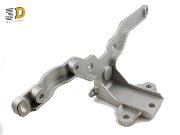Food Safe 3D Printing. Revisted.
Posted on Jan 18, 2017
Food Safe 3D Printing, revisited.
3D Printing containers, utensils, equipment and moulds for producing food products offers food manufacturers a way to very quickly develop test and prove new products for production and market. Since our last blog post things have moved on and we now have some food certificated 3d printer filaments and we offer 316L Stainless Steel 3d printed parts.
Here are some of the considerations when using 3d printing for food related applications:
1. Material certification.
We offer a number of materials with food safety certification, or Stainless Steel which is generally accepted as being food safe:
With specific FDA Food certification:
- Ultem 1010 - FDM filament.
- ABS M30i - FDM filament.
- PA2200 - SLS powder.
Plus:
- Stainless Steel 316L - DMLS (plus other metals. )
2. The 3D Printing process.
In general the material certification tends to relate to the raw material (filament or powder) rather than a finished part. This is because the 3D-Printing stage has a number of variables and these can't be covered by the certification process.
However, 3d printed 316L Stainless Steel parts are over 99% solid and should be equivalent to fabricated parts.
We recommend that you prove the suitability of any 3d printed parts for your application before use.
3. Bacteria and sterilization.
The layered nature of 3D Printing, particularly FDM and SLS can create microscopic voids in which bacteria can grow. This means that for food production you will need a sterilization regime, unless the part is designed to be disposable for single use. Even then, an initial sterilization would be desirable.
PA2200 and Ultem 1010 have good temperature resistance making them candidates for autoclave sterilization techniques.
ABS M30i can be subjected to Gamma Ray sterilization.
3D Printed metal parts are better than 99% solid and can be sterilized as per the usual techniques.
4. Coatings and Sealants.
To counter voids and material composition problems, coating 3d printed parts with a sealant is a potential strategy. Sealants conforming to FDA CFR 175.300 and\or FDA Chapter 1, Section 175.105 requirements are listed here:
http://www.masterbond.com/properties/food-safe-adhesives-sealants-coatings-encapsulation-compounds
They generally offer good temperature and chemical resistance which would make them suitable for common sterilization techniques.
NSF 51 Certification covers 'Indirect' contact with food, ie, for installation in equipment, while NSF 61 covers contact with drinking water.
Traditional manufacturing.
Where 3d printing isn't appropriate we offer a Vac Casting service in food grade Silicones and fabrication in metals.
Turn around times for 3d printed parts are usually quicker than traditional fabrication and allows your designs greater complexity and freedom of design for little or no price penalty.
Please email us for material data sheets and copies of certification and we'll get them over to you.
Latest Posts
3D Printed Materials
OUR CLIENTS SAY

"A great company for all 3D printing needs - friendly, helpful and very fast delivery!"

"I am extremely pleased with the product and experience with 3Dalchemy. The entire process from CAD development to the end product was efficient. I am very happy with the end result! Thank you 3D alchemy for providing us with a great solution! "


